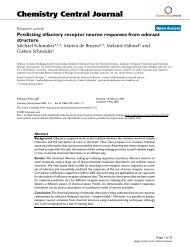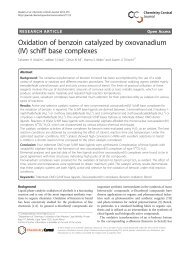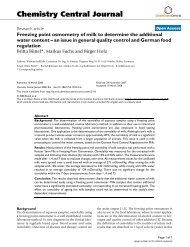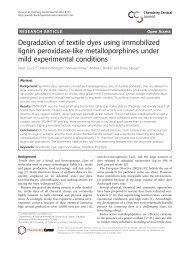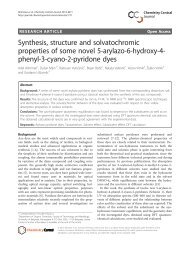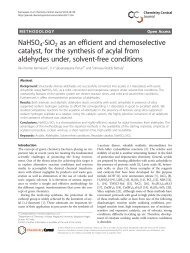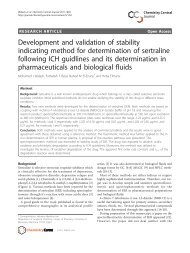Quinazoline derivatives: synthesis and bioactivities - Chemistry ...
Quinazoline derivatives: synthesis and bioactivities - Chemistry ...
Quinazoline derivatives: synthesis and bioactivities - Chemistry ...
You also want an ePaper? Increase the reach of your titles
YUMPU automatically turns print PDFs into web optimized ePapers that Google loves.
Wang <strong>and</strong> Gao <strong>Chemistry</strong> Central Journal 2013, 7:95 Page 11 of 15<br />
http://journal.chemistrycentral.com/content/7/1/95<br />
<strong>derivatives</strong> [6]. Justicidins, the potent bone resorption<br />
inhibitors, were adopted as lead compounds, <strong>and</strong><br />
quinazoline derivative 86 was discovered to show favorable<br />
anti-inflammatory effect on rats with adjuvant arthritis.<br />
Then the structure of compound 86 was modified by<br />
adding heteroaryl moiety on the alkyl side chain at 2-<br />
position of the skeleton, result of which showed that<br />
installation of an imidazole or a triazole moiety on the<br />
2-alkyl side chain could increase the anti-inflammatory.<br />
Then, compound 86 with ED 50 of 2.6 mg/kg/day was<br />
selected as c<strong>and</strong>idate for further research, which showed<br />
that the inhibitory ability against Th1 cytokine production<br />
of 87 was considered to be its significant immune regulating<br />
function (Figure 3).Fifteen [1,2,4] triazole [4,3-c]<br />
quinazoline derivates were synthesized <strong>and</strong> evaluated<br />
for their antimicrobial activity by Jantova et al. [89],<br />
among which, compound 88 (Figure 3) was found with<br />
the highest potency against Bacillus subtilis, Staphylococcus<br />
aureus, C<strong>and</strong>ida tropicalis <strong>and</strong> Rick-ettsia nigricans.<br />
Nasr et al. evaluated the antimicrobial activity of novel<br />
1,2,4-triazolo[4,3-c]-quinazoline analogues against typical<br />
gram-positive bacterium <strong>and</strong> Gram-negative bacterium<br />
[90]. Among these analogues, tetracyclic compound 89<br />
showed higher activity than the reference drug of ciprofloxacin<br />
(Figure 3).Besides, 2-thio-[1,2,4]triazolo[1,5-c]<br />
quinazolinones with C-5 substituted by sulfo-alkyl<br />
groups were discovered with moderate antimicrobial<br />
activity [91-93]. Based on the former researches,<br />
Antipenko et al. synthesized novel 2-thio-[1,2,4]triazolo<br />
[1,5-c]quinazoline <strong>derivatives</strong> <strong>and</strong> investigated their <strong>bioactivities</strong><br />
[8]. Escherichia coli, Pseudomonas aeruginosa, Aspergillus<br />
niger, Mycobacterium luteum, C<strong>and</strong>ida albicans<br />
<strong>and</strong> C<strong>and</strong>ida tenuis were applied in the antimicrobial<br />
test, which showed that compounds 90 <strong>and</strong> 91 exhibited<br />
obvious suppression for C<strong>and</strong>ida albicans, whichwas<br />
validated by further bioluminescence inhibition test<br />
<strong>and</strong> related to their lipophilicity (Figure 3).P<strong>and</strong>ey et al.<br />
also conducted antimicrobial researches on novel<br />
quinazolinones fused with [1,2,4]-triazole, [1,2,4]-triazine<br />
<strong>and</strong> [1,2,4,5]-tetrazine rings [55]. Among the quinazolinones<br />
derivates, compounds 92, 93 <strong>and</strong> 94 (Figure 3) showed excellent<br />
activities against Escherichia coli, pseudomonas<br />
aeruginosa, streptococcus pneumoniae, <strong>and</strong>bacillus subtilis.<br />
Other quinazoline analogues<br />
2,3-Disubstituted quinazolines 2,3-Disubstituted quinazolin-4(3H)-ones<br />
have been discovered with favorable<br />
analgesic <strong>and</strong> anti-inflammatory function [94,95]. Alagarsamy<br />
et al. reported several 2,3-disubstituted quinazoline analogues<br />
with potent analgesic <strong>and</strong> anti-inflammatory activity, such<br />
as 2-phenyl-3-substituted quinazolines [96], 2-methyl-<br />
3-substituted quinazolines [97], 2-methylthio-3-substituted<br />
quinazolines [98] <strong>and</strong> 2,3-disubstituted quinazolines [99]. On<br />
the basis of these researches, they synthesized novel 3-phenyl<br />
-2-substituted-3H-quinazoline-4-ones in purpose of further<br />
reducing the ulceration side effects [5]. And the analgesic,<br />
anti-inflammatory <strong>and</strong> ulcerogenic index activities of these<br />
compounds were tested. Among the synthesized derivates,<br />
compounds 95, 96 <strong>and</strong> 97 (Figure 4) showed moderate<br />
analgesic activity. It is worth to mention that compound<br />
97 exhibited higher anti-inflammatory potency, reference<br />
to st<strong>and</strong>ard drug of diclofenac sodium. In addition,<br />
the evaluated compounds all caused milder ulceration<br />
side effects, reference to aspirin.<br />
Indole-involved quinazolines Indole moiety involved<br />
heterocycles are proved to have a wide variety of pharmaceutical<br />
<strong>and</strong> medical profiles, such as anti-inflammation,<br />
anti-microbial, anti-cancer, anti-malarial, etc. [100-106].<br />
Rohini et al. conducted anti-microbial study on the newly<br />
produced 6-substituted indolo[1,2-c] quinazolines applying<br />
gram-positive bacterium (Staphylococcus aureus,<br />
Bacillus subtilis <strong>and</strong> Streptococcus pyogenes), gram-negative<br />
O<br />
HN<br />
N<br />
X<br />
N<br />
N NH<br />
N R N<br />
1<br />
R 2<br />
98<br />
95 R 1 =CH 3 ,R 2 =CH 2 CH 3<br />
96 R 1 =CH 2 CH 3 ,R 2 =CH 2 CH 3<br />
97 R 1 =CH 3 ,R 2 =CH 2 CH 2 CH 3<br />
Figure 4 Structures of representative other quinazoline analogues.





